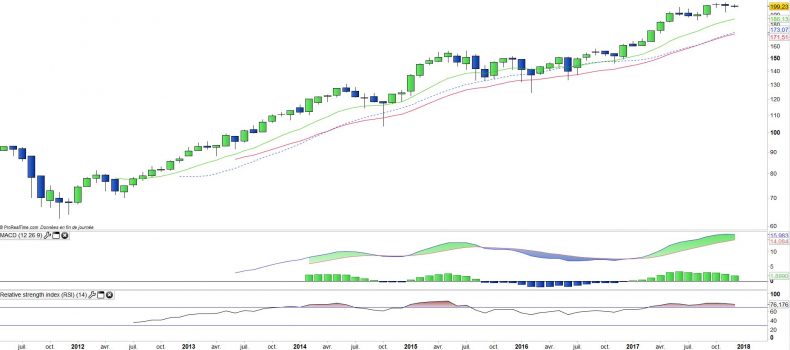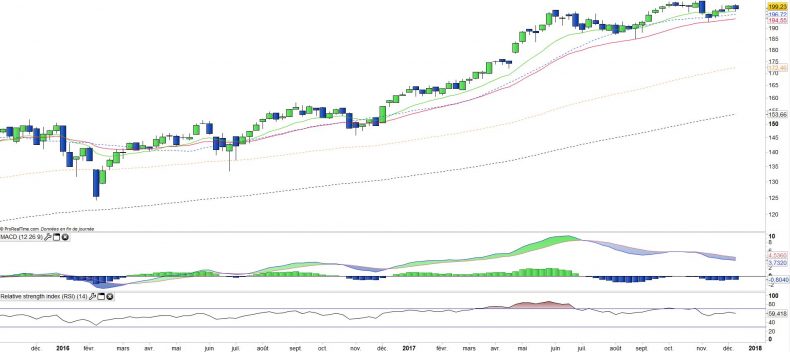Lyxor ETF CAC Mid60 UCITS (CACM) -18/12/2017
Short Term strategy : Positive (80%) / Trend =
Long Term strategy : Positive (95%) / Trend =
Characteristics of the ETF
The CACM ETF (Lyxor), created in 05/2011 is listed in Euro on Euronext Paris and replicates the CAC Mid 60 Gross Total Return index which is composed of 60 French mid-cap companies ranked among the 61st and 120th most traded stocks on Euronext Paris.
The fee of the CACM ETF is 0.5% and the AUM is € 111M. Replication is indirect (via swap) and there is a dividend distribution policy.
Alternative ETFS: EWQ (Ishares)
Index & components
CACMID60 is made up of "big mid-caps", of which the three most represented sectors are industry (21.3%), consumer goods (18.5%) and health (14.7%). The first 10 lines represent 32% of the capitalization and are composed of emblematic growth stocks such as Eurofins Scientifique, Rubis or Orpea but also leading companies in their sectors such as Amundi or Faurecia. Unlike the CAC40, the index does not include banks or major oil companies.
The CACMID 60 index is composed of companies that are more dependent on the domestic market than the world leaders in cac40 but are already very international and very structured. Above all, their growth potential appears on average to be much greater than the large groups of the CAC40, since they often evolve in still fragmented and growing markets (health, technology, consumer goods), but also cyclical for a significant part of the index (industry and materials account for 25% of capitalization), which should continue to benefit from the improvement in the French economy. One of the characteristics of these companies, is that they are more easily targets than the CAC40 groups, because of a lower market capitalization, without the capital being on average more controlled.
The increase in M & A transactions should therefore benefit the index in the coming months. French macroeconomic statistics are improving, but above all the country has eliminated a major risk with the election of Mr Macron, liberal and pro-European. The risk premium linked to the disastrous catastrophe scenario in the euro zone began to decline as soon as the first round results, but the positive impact on French growth linked to the dynamics of the election and hopes for structural reforms and the lowering of corporate and capital taxes -confirmed for the 2018 budget- are still far from being integrated. France is at the beginning of the cycle and strong, positive trends this time are likely to trigger as the fall in unemployment and improvement of growth potential.
The medium-term potential of the index is high, especially as the corporate earnings momentum now seems to have really started after several false starts since 2012, which is confirmed by the solid results of the companies in 2017.
Latest developments
The CACMid60 has increased by 23.6% since the beginning of 2017, a performance well above the CAC40 (+ 10%), as was the case in 2016 (+ 7.9% vs. + 4.9%). Since 2012, the CACMID60 systematically outperforms, and often very largely, the performance of the CAC40, which is reminiscent of the comparison Nasdaq / Dow Jones in the United States, except that in this case the MIDCAC60 index is composed of a wide variety sectors and technology is only one component among others.
We believe that many industrial / cyclical companies offer significant earnings growth potential in 2018 and beyond while expectations of earnings growth remain above 10% in 2018 in a low interest rate environment coupled with moderate oil prices while valuations are now demanding. The exposure to the Euro / USD parity is significantly lower than for the CAC40 companies, but remains an important factor especially for the technology and industry sectors.
On the other hand, Brexit and the evolution of the Pound Sterling / Euro are more important subjects for the French midcaps, which are often quite exposed in the United Kingdom.
Monthly data
The monthly chart shows a very strong long-term trend since 2012 with rare consolidations that are systematically stopped by the EMA26. The index is currently in the high zone after a very strong increase in 2017, and the flattening of the prices and the MACD seem to call for a momentary pause. The averages 13Exp and 26Exp are currently at 7.5% and 14% respectively, which is a good benchmark in case of consolidation.
Weekly data
On the weekly chart, we can observe that prices have been flat since June, but without forming a top pattern. It is rather a prolonged pause after a sharp rise in the first months of 2017. Oscillators are trending down, which creates a worrying divergence with prices but moving averages remain upward. The EMA100, which is the main medium-term support, continues to move closer to prices, which limits the downside potential.
ETF Objective
CACM is a UCITS ETF which replicates the CAC Mid60 Gross Total Return index (59 French companies)
Characteristics
| Inception date | 13/05/2011 |
| Expense ratio | 0,50% |
| Issuer | Lyxor |
| Benchmark | CAC Mid60 Gross Total Return |
| Ticker | CACM |
| ISIN | FR0011041334 |
| UCITS | Yes |
| EU-SD Status | Out of Scope |
| Currency | € |
| Exchange | Euronext Paris |
| Assets Under Management | 111 M€ |
| Dividend | Distribution |
| PEA (France) | Yes |
| SRD (France) | No |
| Number of Holdings | 59 |
| Global Risk | 3/5 |
Country Breakdown
| France | 93% |
| Luxembourg | 5% |
| Netherlands | 2% |
Sector Breakdown
| Industrials | 21% |
| Consumer Discretionary | 19% |
| Health Care | 15% |
| Financials | 13% |
| Real Estate | 10% |
| Information Technology | 10% |
| Materials | 4% |
| Others | 9% |
Top Ten Holdings
| Gecina | 4% |
| Eurofins Scientific | 4% |
| Rubis | 4% |
| Faurecia | 3% |
| ADP | 3% |
| Bolloré | 3% |
| Ubisoft | 3% |
| Amundi | 3% |
| Orpéa | 3% |
| Rexel | 3% |


